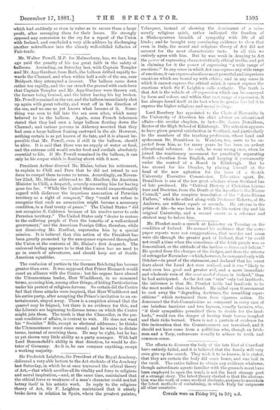Sir Frederick Leighton, the President of the Royal Academy, delivered
a very able lecture to the Art students of the Academy last Saturday, in which he at once traversed the ethical theory of Art,—that which ascribes all its vitality and force to religious and moral inspiration,—and, at the same time, maintained that the ethical force or weakness of a man's character could not but betray itself in his artistic work. In reply to the religions theory of Art, Sir F. Leighton maintained that it utterly broke down in relation to Spain, where the greatest painter, Velasquez, instead of showing the dominance of a vehe- mently religious spirit, rather indicated the freedom of a Shakespearean breadth of sympathy with life of all kinds ; and he brought very convincing evidence to show that even in Italy, the moral and religious theory of Art did not account for the most characteristic facts. In all this we entirely agree with him. But he was weak in denying to Art the power of expressing characteristically ethical truths, and yet in claiming for it the power of expressing "a wide range of emotions." In any sense in which Art can express any wide range of emotions, it can express also those most powerful and imperious emotions which are bound up with ethics ; and in any sense in which it cannot express the ethical mind, it cannot express the emotions which Sir F. Leighton calls ;esthetic. The truth is that Art is the vehicle of all expression which can be conveyed by form and colour, and within that vast range of expression, it has always found itself at its best when its genius has led it to express the higher religious and moral feelings.










































 Previous page
Previous page